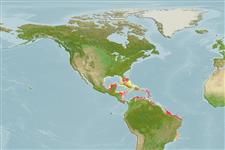Common names from other countries
Classification / Names / Names
народные названия | синонимы | Catalog of Fishes (gen., sp.) | ITIS | CoL | WoRMS
Environment: milieu / climate zone / depth range / distribution range
экология
; солоноватоводный; пределы глубины 1 - 24 m (Ref. 86836). Tropical; 25°C - 33°C (Ref. 86836)
Western Central Atlantic.
Length at first maturity / Size / Вес / Возраст
Maturity: Lm ? range ? - ? cm Max length : 0.5 cm OT самец/пол неопределен; (Ref. 415)
Encrusting, up to 0.5 cm thick, very soft and fragile. Raised dermal canals converge to oscula with transparent membranes: 0.1 - 0.3 cm in diameters. Bluish, pinkish or creamy yellowish in shaded zones (Ref. 415).
Maximum thickness: 0.5 cm (Ref. 415). Maximum depth from Ref. 114748. Rare, encrusting mangrove roots (Ref. 415).
Life cycle and mating behavior
половая зрелость | размножение | нерест | икра | Fecundity | личинки
Members of the class Demospongiae are hermaphroditic. Life cycle: The zygote develops into parenchymella larva (free-swimming) before settling down on a substrate where it grows into a young sponge.
Основная ссылка
ссылки | координатор | соавторы
Collin, R., M.C. Díaz, J. Norenburg, R.M. Rocha, J.A. Sánchez, M. Schulze, A. Schwartz and A. Valdés. 2005. (Ref. 415)
Статус Красного Списка МСОП (Ref. 130435)
Статус СИТЕС (Ref. 108899)
Not Evaluated
Not Evaluated
Угроза для людей
Harmless
Использование человеком
| FishSource |
инструменты
дополнительная информация
Возраст/РазмерыростЗависимость между длиной и массой телаЗависимость между длинамиморфологияличинкичисленность
ресурсы в Интернет
Estimates based on models
Preferred temperature
(Ref.
115969): 26.3 - 28.4, mean 27.2 (based on 216 cells).
Уязвимость
Low vulnerability (10 of 100).
Категория цены
Unknown.
